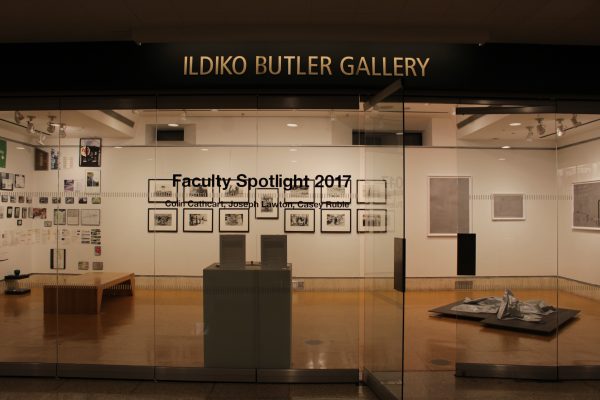A Variety of Visual Arts on Display in Gallery
Before the opening night of the faculty show at the Ildiko Butler Gallery on January 25, 2017. (ASEAH KHAN/THE OBSERVER)
February 9, 2017
Located inside Fordham College at Lincoln Center’s (FCLC) main entrance, the Ildiko Butler Gallery is holding its annual Faculty Spotlight showing. This year, three professors from the Visual Arts Department are presenting their work: Associate Professor Colin Cathcart, American Institute of Architects (AIA) medalist, Associate Professor Joseph Lawton and artist-in-residence Casey Ruble.
The left side gallery contains the architectural designs of Professor Cathcart. Displaying over 40 years of architectural projects, drawings, writings, models and awards, Cathcart not only presents his viewers with green and sustainable architectural designs, but also the personal history of his architectural career. Starting with his framed high-school diploma at the Central Technical School in Toronto, Cathcart’s early work in the mid-’70s are hand-drawn sketches, as technology was not developed enough yet for virtual architectural design. One of the designs he is proudest of was featured on a calendar in the 1980s that is found in the center of his exhibition—it was one of Cathcart’s first designs on a computer.
“It shocked so many people that a computer could create something so realistic,” Cathcart said. “It even was displayed in a prestigious exhibition, which was very exciting.”
A few other noteworthy pieces are his wire sculpture prototype of a weather mast, his sketch of “The (old) New Museum,” which has been renovated into a clothing store, and his Green Apple Award that he received in 2005 for housing the homeless. “We’ve been green since 1983,” Cathcart said. His exhibition finishes off with some of his current sketches and designs.
Located on the center wall of the gallery is an excerpt of Professor Lawton’s “Made in Time.” A series of 10 photos derived from a larger body of work titled “Plain Sight,” Lawton chose to display this specific portion so that each photo “can be read on their own or in relation to each other.” These photos range from 1983 to 2014 and were taken all around the world including New York, Italy, Sulawesi, Russia, Vietnam, El Salvador and Turkey. “Visual poetry can be found in the everyday life,” Lawton explained, “and realizing that, seeing, is a gift.”
From photos of women looking for change in Russia to children in Saigon, Vietnam observing a chained-up elephant in a zoo, Lawton wanted to capture the scenes of his photos as he saw it. “There is a great joy of just looking,” Lawton explained. The prints of his photos in the gallery were even printed in the dark room at Fordham University—a modest tribute to the college.
Lastly, the right side of the gallery displays the work of Fordham’s artist-in-residence, Casey Ruble, titled “Great Wandering Shadows.” Depicting ordinary areas found today—a diner, a bathroom stall, a school, an elevator—Ruble’s work provides a deeper historical meaning by depicting the gentrified locations of four major riots dating back to the 1800s.
“Disconnecting people from their roots in this way is a powerful means of perpetuating their oppression,” Ruble stated. “My hope with these pieces is to remind people that no matter how mundane, anonymous or bleak their surroundings may seem, that place has a backstory, and knowing that backstory may give you a sense of agency you may not have felt otherwise.”
Ruble’s creative process began with intensive research on a specific riot, then visiting the location and taking photos of the area. Next, she selected the picture she wanted to work from—“generally one that gives a sense of what the place feels like today, but also has a strangeness that suggests a hidden history.” After translating the scene to paper, the artist researched the location and history of the area further for articles and press releases accompanying her work.
In addition to these four pieces is a paper effigy found on the floor of the gallery in dedication to the Zoot Suit riots of 1943. “Effigies have an interesting history,” Ruble explained. “In some cases they are burned as an act of protest against the person they represent. In others, they serve as a consecration of the person. I thought this dichotomy was interesting, complicating ideas of condemnation and commemoration and alluding to the complicated meaning that riots continue to have in the history of our country.”
These works are on view at the Ildiko Butler Gallery until Feb. 13.










